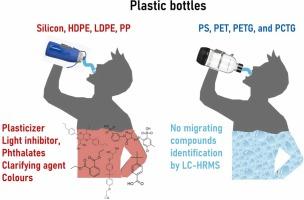可重复使用塑料瓶的化学迁移:有机硅、聚乙烯和聚丙烯在 LC-HRMS 分析中显示出最高的危害潜力
IF 12.2
1区 环境科学与生态学
Q1 ENGINEERING, ENVIRONMENTAL
引用次数: 0
摘要
由于可重复使用塑料瓶中有意或无意添加了大量化学物质,因此估算可重复使用塑料瓶中储存的饮用水的化学危害具有挑战性。为了解决这个问题,我们开发了一种广泛的筛选策略,利用蒸发富集和液相色谱高分辨质谱法(LC-HRMS)来评估非挥发性化学品从各种可重复使用塑料瓶中的迁移。该研究分析了多种材料,发现不同类型的瓶子在化学特征方面存在显著差异。在近 1000 种未知化合物中,70% 以上是特定瓶子所特有的。硅胶瓶、高密度聚乙烯瓶、低密度聚乙烯瓶和聚丙烯瓶的迁移率最高,其中硅胶瓶释放的未知化合物最多,但也释放邻苯二甲酸盐和增塑剂。聚丙烯瓶显示出澄清剂和双酚 A 衍生物的迁移。相比之下,PS、PET、PETG 和 PCTG 的迁移率最低,表明健康风险较低。这些发现凸显了对塑料材料进行全面评估以提高消费者安全的必要性。本文章由计算机程序翻译,如有差异,请以英文原文为准。

Chemical Migration from Reusable Plastic Bottles: Silicone, Polyethylene, and Polypropylene show Highest Hazard Potential in LC-HRMS Analysis
Estimating the chemical hazards of drinking water stored in reusable plastic bottles is challenging due to the numerous intentionally and unintentionally added chemicals. To address this, we developed a broad screening strategy using evaporation enrichment and liquid chromatography high-resolution mass spectrometry (LC-HRMS) to evaluate migration of non-volatile chemicals from various reusable plastic bottles. The study analyzed a wide range of materials, revealing significant variability in chemical profiles across different bottle types. Over 70% of nearly 1,000 unknown compounds were unique to specific bottles. Silicone, HDPE, LDPE, and PP bottles showed the highest migration rates, with silicone releasing the most unknowns, but also phthalates and plasticizers. PP bottles exhibited concerning migration of clarifying agents and bisphenol A derivatives. In contrast, PS, PET, PETG, and PCTG had minimal migration, indicating lower health risks. These findings highlight the need for comprehensive assessments of plastic materials to improve consumer safety.
求助全文
通过发布文献求助,成功后即可免费获取论文全文。
去求助
来源期刊

Journal of Hazardous Materials
工程技术-工程:环境
CiteScore
25.40
自引率
5.90%
发文量
3059
审稿时长
58 days
期刊介绍:
The Journal of Hazardous Materials serves as a global platform for promoting cutting-edge research in the field of Environmental Science and Engineering. Our publication features a wide range of articles, including full-length research papers, review articles, and perspectives, with the aim of enhancing our understanding of the dangers and risks associated with various materials concerning public health and the environment. It is important to note that the term "environmental contaminants" refers specifically to substances that pose hazardous effects through contamination, while excluding those that do not have such impacts on the environment or human health. Moreover, we emphasize the distinction between wastes and hazardous materials in order to provide further clarity on the scope of the journal. We have a keen interest in exploring specific compounds and microbial agents that have adverse effects on the environment.
 求助内容:
求助内容: 应助结果提醒方式:
应助结果提醒方式:


